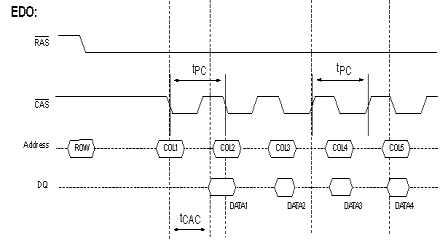Ram Guide
HyperPage Mode (EDO)
The last major improvement to asynchronous DRAMs came with the Hyperpage mode, or Extended DataOut. This innovation was simply to no longer turn off the output buffers upon the rising edge of /CAS. In essence, this eliminates the column precharge time while latching the data out. This allows the minimum time for /CAS to be low to be reduced, and the rising edge can come earlier.
In addition to a 40% or greater improvement in access times, EDO uses the same amount of silicon and the same package size. EDO has been shown to work well with memory bus speeds up to 83 MHz with little or no performance penalty. If the chips are sufficiently fast (55ns or faster), EDO can be used even with a 100 MHz memory bus. One of the best reasons to use EDO is that all of the current motherboard chipsets support it with no compatibility problems, unlike much of the synchronous memory now being used.
Even with all the stated advantages, EDO is no longer considered mainstream. Most manufacturers no longer produce it, or have limited production. It is only a matter of time before the prices begin to rise, and the equivalent size SDRAM module will be less expensive.
If you already own EDO memory, there is no real reason to jump to SDRAM unless you require bus speeds above 83 MHz. With a typical EDO timing of 5-2-2-2 at 66 MHz, there is almost no noticeable improvement with SDRAM over EDO, and at 83 MHz it is still negligible. If you require 100 MHz bus operation, EDO will lag far behind current SDRAM in performance even if it does operate at that speed due to the need for 6-3-3-3 timings. On the other hand, with EDO being phased out, you will likely find SDRAM to be equal to or even lower in price.
Get Tom's Hardware's best news and in-depth reviews, straight to your inbox.
